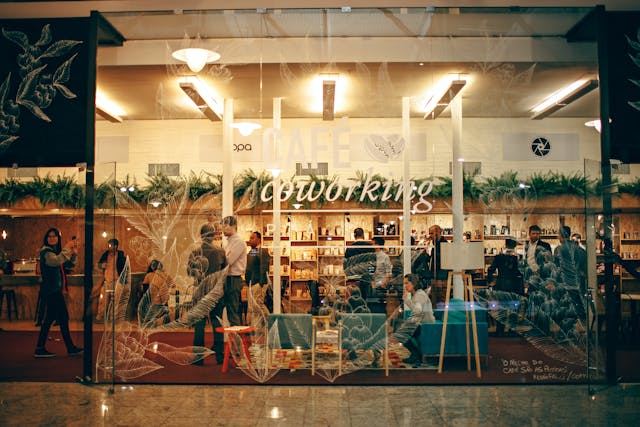
The generalised adoption of remote work has significantly reshaped the landscape of the office real estate market worldwide. London, as a global business hub, has also experienced significant shifts in office space demand and in its rental dynamics due to the rise of remote and hybrid work. In this article, we’ll explore the impact of remote work on London office rentals, analysing key trends, challenges, and opportunities for office-based companies.
Remote Work in London: Key Facts and Figures
- In early 2024, a survey found that 59% of Londoners worked remotely to some extent.
- London has had the 9th highest increase in the number of remote / hybrid job postings since 2020, and the total share of remote job postings for the capital city is around 13% of all advertised positions.
- Data from the Office for National Statistics confirm that London has the highest amount of remote workers in the UK, with 4 in 10 working from home as opposed to a national average of 2 in 10.
- In 2023, the average worker in London went to the office 2 days per week as opposed to 4-5 days pre-pandemic.
- Companies in the city’s professional services sector are the most likely to adopt fully remote or hybrid work practices.
Next, let’s look at how the figures above translate into office real estate trends within the city.
Changing Space Requirements
As a result of remote work practices, many London companies have embraced flexible work patterns that allow employees to split their time between home and the office.
This shift has led to a reduced need for dedicated office space, as companies who embrace remote work tend to prioritise real estate solutions that offer flexibility and cost savings. According to some estimates, London-based businesses that allow 20% of their staff to work remotely can save nearly £28,000 a year on office rent.
Downsizing is the most noticeable effect of remote work arrangements. A quarter of all London businesses have opted for reducing their office footprint by 20%, and in early 2024, the average deal size in The City went down to 8,500 sq ft from 15,400 sq ft.
Vacancy Rates Soar in Some Central London Markets
The impact of the downsizing trend mentioned above is more evident in some sub-markets, like Canary Wharf, where relocations are contributing to vacancy rates of around 19%.
In the City, vacancy rates have increased by nearly 2 percentage points in just one year, reaching averages of 12% in Q1 2024. Also in central London, West End vacancy rates increased to nearly 10%.
In the year 2023-2024, vacancy rates have been higher in downtown areas than in suburban markets, with all-class averages being 29% and 11% respectively.
Quality over Quantity
The ongoing increases in vacancy rates don’t affect all office classes. This is not to say that central London offices no longer generate interest, since there’s strong demand and very limited vacancies for the best-quality offices.
In fact, more than 80% of take up volume in central London was for Grade A or new office units. What’s more, prime and Grade A assets are still experiencing rental growth, due to increased competition for smaller but better equipped offices. These assets are expected to continue accruing gains well into 2028.

Increased Focus on Flexible Workspaces
Flexible workspaces like co-working spaces and serviced office providers have experienced a surge in popularity among businesses seeking agile solutions while they adapt to full time remote or hybrid work. These solutions offer flexibility and scalability, allowing companies to adjust their requirements to changing needs without the long-term commitment of traditional leases.
A 2023 survey of 500 London-based companies revealed that 18% were resorting to flexible and coworking options as part of their commercial real estate strategy.
We’re also seeing an increased specialisation in the type of flexible space offered, with many operators opting to cater to the specific needs of an industry sector instead of offering generic flexible space.
Overall, there was a 9% increase in the average price of coworking desks in London between 2023 and 2024 alone. Coworking spaces in the City have some of the highest occupancy rates in London at nearly 90%.
Emphasis on Employee Well-Being
To incentivise the return to the office, many business are focusing on creating office environments that prioritise employee well-being. This is typically done by investing in wellness amenities, communal spaces, and flexible layouts that support team satisfaction and productivity.
The best-rated office amenities now include outdoor and breakout spaces, parking, eating / catering, and gym or fitness spaces.
Sustainable office features are also in high demand and are proving to be profitable, since offices with the best sustainability ratings drove more than half of all London transactions in 2023.
Future Outlook
London businesses are expected to shift their office requirements towards short-term arrangements that prioritise agility and scalability. Market analysts suggest that in the near future, typical office leases are more likely to fall within the 5-8 year range instead of the traditional 10 to 15 years.
As many London companies choose to downsize while favouring offices with high-quality specs, the question is what will happen to secondary office assets in the city. Many are scheduled for conversion to other uses, such as hotel or student accommodation. Other property owners are converting underutilised office buildings into mixed-use developments, incorporating residential, retail, and leisure components to diversify revenue streams and enhance property value.
The trend towards sustainability is also expected to become more consolidated in everything from construction materials to office systems. This will not only enhance employee wellness, but can also attract longer leases at higher premiums.
Conclusion
The large-scale adoption of remote work has caused important changes in the London office market, since many office occupiers are reassessing their space needs. As businesses adapt to the evolving needs of their workforce and the market, the demand for flexible, adaptable, and high-spec office solutions is expected to remain strong.
Did you find this article helpful? We’d love to hear your feedback, especially if you have experiences related to remote London work and its impact on your office space rental needs. Connect with us on our social media channels on Facebook and Twitter / X to share your thoughts.
If you’re searching for commercial property across the UK, explore our cost-effective workspace options available in Central London, Greater London, The North, and The South. For inquiries, please contact our commercial property experts at 020 3970 9731; they are ready to assist you.
Interested in more news and guides?
Click on the links below for additional insights on the workplace.
End of Commercial Lease: What Happens | UK Checklist
Decoding Common Area Maintenance Charges: What You Need to Know
The Difference Between Office Grades (Grade A, B and C Explained)
The Role of Natural Materials in Sustainable Office Design
Exploring the Best Co-Working Spaces Manchester Has to Offer
UK Economic Outlook: Late-2022
Office Safety Tips | 11 Ways to Improve Your Workplace
15 of the Best Business Parks in the UK
Hybrid & Flight to Quality – Changing the UK Office Landscape

